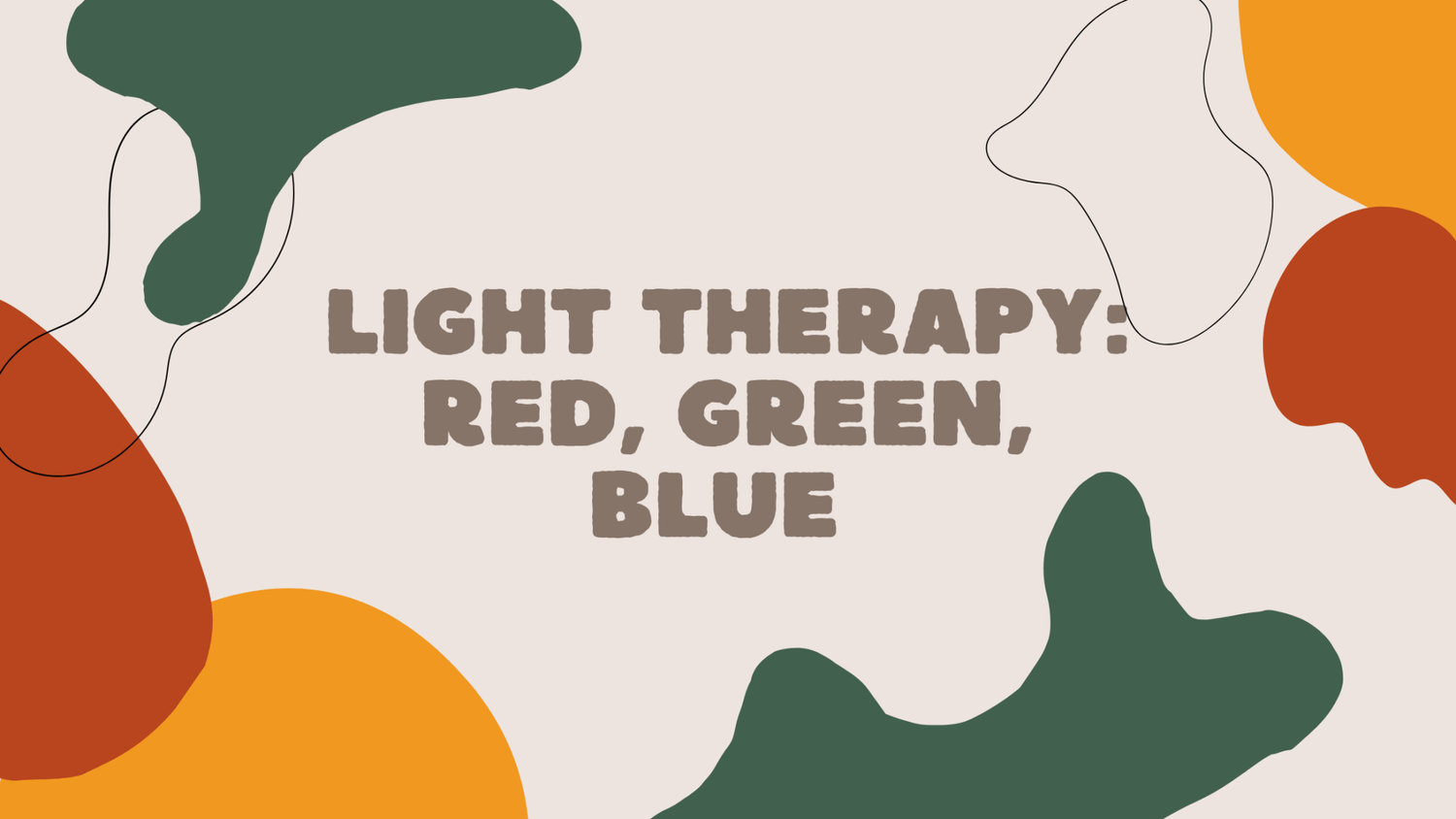Date Goes Here
Light Therapy Types: Red, Green, and Blue
Date Published

Background
In this article, we'll explore the different types of light therapy, including the popular red light therapy and the emerging green light therapy, along with blue light therapy and techniques you can try at home to boost your well-being.
Table of content
Light is more than just something that helps us see—it has a profound effect on our health and well-being. Different types of light exposure can influence our mood, energy levels, sleep patterns, and even physical healing. This is the foundation of light therapy, a treatment that uses specific wavelengths of light to address various health concerns.
The Science Behind Light Therapy
Light therapy involves exposing the skin or eyes to different wavelengths of light. These wavelengths are absorbed by the body’s cells and tissues, triggering biological processes that help improve physical or mental health. Different colors of light penetrate the skin to varying depths and have unique effects on the body, which is why various forms of light therapy exist.
Common applications of light therapy include:
- Improving mood and reducing symptoms of depression, especially Seasonal Affective Disorder (SAD), which occurs during the winter months .
- Regulating sleep patterns by influencing the body’s circadian rhythms .
- Promoting skin healing by accelerating tissue repair and reducing inflammation .
- Boosting energy levels and improving athletic performance .
Types of Light Therapy
What is Red Light Therapy?
Red light therapy (RLT) involves exposing the body to low levels of red or near-infrared light. It is often referred to as low-level laser therapy (LLLT) or photobiomodulation. This type of light penetrates the skin and is absorbed by cells, particularly the mitochondria, the powerhouse of the cell. Red light therapy helps enhance energy production within the cells, promoting healing and regeneration .
Benefits of Red Light Therapy:
- Skin rejuvenation: It stimulates collagen production, reducing fine lines, wrinkles, and scars .
- Wound healing: Red light therapy speeds up tissue repair and reduces inflammation, making it useful for treating cuts, burns, or other skin injuries .
- Pain relief: It’s known to help reduce muscle pain, joint pain, and inflammation .
- Improved sleep: Red light can help regulate sleep patterns by influencing the body’s melatonin production .
What is Green Light Therapy?
Green light therapy is a newer form of light therapy that focuses on treating certain health issues, particularly related to pain management and mental health. While it hasn’t received as much attention as red light therapy, early research is showing promising results .
Benefits of Green Light Therapy:
- Migraine relief: Green light exposure can help reduce the frequency and intensity of migraines .
- Anxiety reduction: Green light has a calming effect and may help reduce feelings of anxiety and stress .
- Pain management: Green light therapy has been used in studies to manage chronic pain .
What is Blue Light Therapy?
Blue light therapy is a popular treatment for acne and other skin conditions. It uses specific wavelengths of blue light (between 400 to 490 nanometers) to target Propionibacterium acnes (P. acnes), the bacteria responsible for acne. Blue light kills these bacteria without harming surrounding skin .
Benefits of Blue Light Therapy:
- Acne treatment: It is primarily used to treat acne by killing bacteria that cause breakouts .
- Sun damage and precancerous skin lesions: Blue light therapy can treat actinic keratosis, a precancerous skin condition caused by sun exposure .
- Psoriasis: Blue light therapy may help manage psoriasis, a chronic skin condition .
Light Therapy Techniques at Home
Many light therapy treatments are now available for home use. Here are a few ways you can incorporate light therapy into your wellness routine:
1. Red Light Therapy Devices
Portable red light therapy panels, wands, and masks allow you to target specific areas of the body for skin health, pain relief, or wound healing. Red light therapy can be done for a few minutes a day using devices that are safe for at-home use .
2. Light Therapy Lamps for SAD
If you suffer from Seasonal Affective Disorder or low energy in the winter, a light therapy lamp can mimic natural sunlight. Use it for 20-30 minutes each morning to help regulate your circadian rhythm and improve mood .
Light therapy lamps, also known as SAD lamps or phototherapy lamps, typically use full-spectrum bright light that mimics natural sunlight. These lamps emit light that ranges between 2,500 and 10,000 lux, which is much brighter than ordinary indoor lighting but similar to outdoor light on a clear day.
The light is usually cool white or blue-enriched light, designed to simulate the beneficial effects of natural sunlight without harmful ultraviolet (UV) rays. Many light therapy lamps come with UV filters to ensure the light is safe for prolonged exposure. They are primarily used to treat Seasonal Affective Disorder (SAD) and help regulate circadian rhythms by providing bright light exposure during the darker months.
3. Blue Light Therapy for Acne
Handheld blue light therapy devices, often in the form of masks or wands, can help reduce acne breakouts by targeting bacteria on the skin. Use these devices according to the manufacturer’s instructions for best results .
4. DIY Sunlight Exposure
Natural sunlight is a powerful form of light therapy that can help improve mood, sleep, and vitamin D levels. Aim for 10-30 minutes of sunlight exposure daily to reap the benefits .
TL:DR
Blog posts
View all-

The Benefits of Training Barefoot
Discover how training outdoors and grounding with the Earth can reduce stress, boost recovery, and elevate performance naturally and effectively.
The Benefits of Training Barefoot
Discover how training outdoors and grounding with the Earth can reduce stress, boost recovery, and elevate performance naturally and effectively.
-

Innovations in Fitness Tools & Technologies
Opening Anecdote I was about a year into kettlebell training when I started noticing something in the gym: notebooks and apps everywhere—people either scribbling down workouts or scrolling through plans...
Innovations in Fitness Tools & Technologies
Opening Anecdote I was about a year into kettlebell training when I started noticing something in the gym: notebooks and...
-

The 6 Most Common Running Injuries and How to P...
Running is one of the most accessible and effective forms of exercise, but it comes with risks—especially if proper precautions aren’t taken. Overuse injuries plague runners of all experience levels,...
The 6 Most Common Running Injuries and How to P...
Running is one of the most accessible and effective forms of exercise, but it comes with risks—especially if proper precautions...



